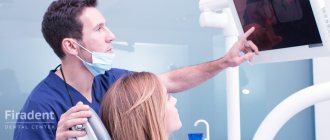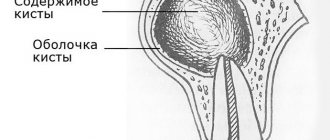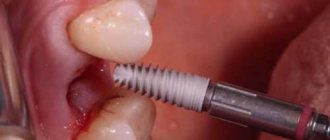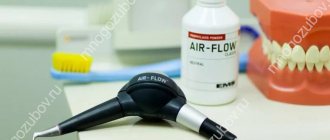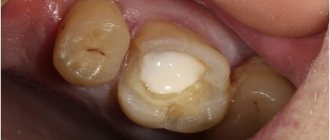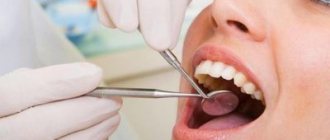There are a huge number of diseases in dentistry that can be cured only by removing problematic teeth. Many patients are mistaken in believing that a tooth is just a bone, the diseases of which cannot cause serious complications to the body. In fact, the tooth has a complex structure: it consists of a hard enamel layer, loose dentin and a neurovascular bundle. The infection can spread through the dentinal tubules into the dental pulp, where the nerves and blood vessels are located. When it is damaged, the tooth begins to hurt severely.
If treatment is not started in time, periodontitis (a connective tissue disease) develops, which is accompanied by the collapse of the neurovascular bundle. In this clinical situation, the concentration of pathogenic microflora in the canal increases. If endodontic treatment is delayed, the infectious process spreads to the periapical area, and from there to the bone. In this case, serious damage to the bone material is observed with a violation of its integrity. When the bone is severely degraded, the teeth become loose and unsupported and eventually have to be removed.
The inflammatory process can spread from one dental unit to others, leading to their infection. Most often, this situation occurs with periodontal disease. If left untreated, all neighboring teeth will become infected and it will be impossible to cure them.
The dentists at Dr. Granov’s clinic always try to preserve the patient’s teeth, but if this is not possible, they advise removing the diseased teeth.
Delete cannot be left
“The smart ones remove wisdom teeth,” many Russian dentists say. They are sure that it is best to get rid of eights during the period of change in bite, when the jaw bones have not yet “increased” sufficient density.
But so far this opinion is not shared by everyone, and opponents present well-founded arguments. The main one is the possibility of using the “sage” as a support for a bridge.
Most often, wisdom teeth are removed if they are incorrectly positioned and have difficulty erupting. For various reasons, they grow inside the jaw bone and may never overcome the gum barrier. The operation to extract such teeth is quite difficult, and it is recommended to do it in maxillofacial surgery.
Wisdom teeth are no different in appearance from other molars. They have the same crown and developed roots, but functionally they are far behind the sixes and sevens. Eights practically do not participate in the chewing process and serve only as a kind of fence that protects the dentition from divergence and loosening.
In 8 out of 10 patients, wisdom teeth cause problems with eruption.
How many teeth can be removed in one visit?
Extraction (removal) of teeth is a kind of trauma for the body. If more than one tooth is pulled out, then at the end of the operation a large wounded surface remains in the mouth. It heals much more slowly and can lead to complications. The prolonged absence of two or three teeth at once is undesirable, because it affects the distribution of the load between the teeth, the natural correct functioning of the jaw is lost, and the dentition is deformed. Since the wound will heal more slowly, various microbes may accumulate in it. Possible infection. It is recommended that no more than one tooth be removed per dental appointment. If the situation is good, namely that you have unimpeded signs for removal, it is possible to extract 2 teeth at once. But no more than 3! Removing two teeth at once is possible provided that two teeth located next to each other are already lost and cannot be treated. During preparation for extraction, the dentist assesses the general condition of the person and his absence of viral diseases. Removal of two teeth is possible only if the patient personally wishes. If the patient is not ready to undergo such an operation, then one, most damaged, tooth is removed.
Contraindications
- absence of sixes and/or sevens in the dentition;
- correct placement in the jaw, not harming neighboring teeth;
- the possibility of conservative treatment of figure eight;
- loosening of neighboring units, which require a figure eight to splint.
In Russia, it is considered advisable to preserve wisdom teeth, if possible. Their removal is postponed for as long as possible, although most often they have to come back to it again.
Even if a wisdom tooth is treated and the canals are filled, it does not “live” for long. The reason is the inconvenient location, which complicates hygienic care. Food plaque accumulates on the enamel, and the tooth quickly deteriorates.
Difference between sedation and anesthesia
Sedation is simply a sleeping pill that puts the patient into a shallow sleep. At the same time, he breathes on his own, he retains all vital reflexes, he can respond to the doctor’s requests, and after the procedure he can calmly go home. Anesthesia is more global. The patient is put into deep sleep, undergoes mandatory intubation, and during the treatment, his breathing and cardiovascular activity are supported and controlled by devices. After recovering from anesthesia, he must be under the supervision of a doctor for at least 30 minutes, and to return home he must be accompanied by someone close to him. Therefore, use general anesthesia only because the patient is afraid. In addition, there are sad statistics according to which, after dental treatment under anesthesia, fear not only does not go away, but intensifies even more.
Features of complex operations
Removing eights becomes more difficult if:
- location on the lower jaw. The lower teeth have a more massive and developed root system, and higher jaw bone density;
- tooth growth at an angle to the dentition or in a horizontal direction;
- incomplete eruption;
- tortuosity, entanglement of roots, especially when there are many of them;
- proximity of neighboring units, making it difficult to remove the figure eight;
Complex removals can be performed not only under local anesthesia, but also with sedation. Painkillers are administered together with sedatives and are selected individually. Operations under sedation provide psychological comfort and painlessness.
There are two types of extraction
Planned removal is prescribed if:
- A diseased tooth cannot be cured;
- The patient has a growth pathology - the tooth is positioned incorrectly, injures the tissues in the oral cavity or interferes with nearby teeth;
- The crown of the tooth is completely destroyed.
Emergency extraction is performed if the patient:
- Purulent periodontitis – acute inflammation develops in the periosteum;
- There is a process of bone destruction due to jaw osteomyelitis.
Signs of periostitis are:
- Throbbing sharp pain;
- Temperature increase;
- Edema.
In such cases, you cannot take measures on your own. Rinsing and warming up will not only not help, but will also worsen the situation.
Modern anesthetic drugs allow tooth extraction to be performed without pain. Anesthesia can be carried out in stages: first, the surface of the gums is covered with gel, and only after that the main anesthetic is administered.
Removal varies in difficulty. In any case, the tissues of the oral cavity are injured and complications are possible. Manipulation requires the professionalism of a dentist.
Easy removal
If the above features are not present, then the removal of the figure eight is carried out in the usual way. The total time of the procedure is about half an hour, but the tooth itself is removed quickly - in about 10 minutes. The rest of the time is spent on preparing and suturing the wound (if necessary).
The standard algorithm is:
- The dentist questions the patient about existing diseases, drug allergies and general health.
- Based on the data obtained, an anesthetic and sedative agent are selected.
- An anesthetic injection is given, and after it begins to act, the doctor begins to remove the eighth tooth.
- The tooth is loosened using forceps and removed from the jaw in one motion.
- Medicine or plasma membrane is placed in the socket to prevent inflammation and promote healing.
- If necessary, stitches are applied. This is usually required when removing the bottom eights.
Simple removal very rarely causes complications and is quite easily tolerated.
Anesthesia
Before the operation, complete anesthesia of the required area of the jaw is carried out. The most commonly used is local anesthesia, which is carried out using a carpule syringe and an anesthetic. Anesthesia of the lower jaw occurs 8-10 minutes after the injection. The duration of the analgesic effect depends on the drug used and is 2-4 hours. The operation itself is completely painless, but after the anesthetic wears off, the patient begins to feel pain. Therefore, after the procedure, the specialist gives prescriptions about the need to use medications (painkillers, anti-inflammatory, antimicrobial agents).
Removing 4 eights in one session
Removing all the sages at once can be a very reasonable and rational decision for certain indications. Most often, one-stage extraction is carried out for orthodontic indications, when it is necessary to install braces or corrective aligners.
The main advantage of such surgical treatment is the uniform and symmetrical movement of dental units due to the voids formed in the jaw in place of the sockets. After about 2 months, the sockets are overgrown with new bone, and the teeth can no longer move as easily and quickly. Thus, the duration of treatment by an orthodontist is reduced.
If removal is carried out for other indications, then this also has its advantages:
- When teeth are crowded, they move apart, thereby aligning the dentition. Otherwise, the doctor may recommend wearing special aligners to contain the process, in order to avoid the formation of large interdental gaps in the row;
- manipulations are performed by two dental surgeons in an average of 1 hour;
- anesthesia or sedation is carried out once, and not several times, if you part with the eights in turn;
- It is enough to take antibiotics only once instead of four times, which is especially important for chronic diseases;
- discomfort, pain and inconvenience when eating also will not have to be experienced twice.
What does a dentist consider when choosing removal options?
For dental operations, 2 types of anesthesia are used: local and general. In the second case, the risks of an overdose of anesthetics and the occurrence of complications associated with them are practically absent, but the body receives an increased dose of analgesics, which can also not have the best effect on its condition.
In each case, when choosing a one-time removal of one or more teeth, the dental surgeon takes into account:
- Health group, the patient’s well-being, the presence of acute, chronic pathologies, allergic reactions to certain drugs.
- The likelihood of complications during general or local anesthesia (dizziness, disorders of the digestive system, impaired coordination of movements, functioning of the respiratory system, etc.)
- Dosage, side effects, indications and contraindications of drugs that should be used for pain relief.
- Is there a risk of damage to adjacent areas of the dentition when several teeth are removed?
- The presence of various pathologies in the oral cavity, including periodontitis, periodontal disease.
- Psychological state of the patient - if he experiences a difficult-to-control fear of medical procedures, the number of the latter must be reduced to a minimum.
It is important to know: even with general anesthesia, it will not be possible to remove a large number of diseased teeth! This approach to getting rid of damaged parts of the dentition is dangerous because it slows down the healing process of wounds and significantly increases the risk of bleeding and inflammation.
All 4 at once: arguments against
Despite the current practice, when during 1 visit you can part with only one, maximum two teeth, there are no restrictions on the number of teeth removed. It all depends on the specific case, and there are contraindications.
For example, if a wisdom tooth is to be cut out, then multiple removals are not performed due to severe damage to the gums. A wound that is too large will make the recovery period more difficult and longer.
4 eights at the same time cannot be extracted in hypertensive patients and those who take anticoagulants - blood thinning drugs. These patients have an increased risk of major bleeding.
Sometimes it is necessary to inject a large volume of anesthetic in order to effectively numb the surgical sites. But there are certain limits beyond which you cannot go. If the required amount of anesthetic exceeds the permissible level, then several interventions are performed, not just one.
There are no problems with the anesthetic when removing two adjacent teeth in a row: in this case, it is not necessary to chip the jaw in several places.
Another reason for refusing multiple removals is the patient’s reluctance to experience significant difficulties during the rehabilitation period. After extraction of 4 teeth, pain will occur in 4 places, and in the first days the pain can spread to all jaws. But a number of patients, on the contrary, strive for just this option, preferring to “get over it” once and for all.
The extraction of all 4 wisdom teeth is also not carried out in case of severe inflammation of the gums, as this can provoke a large-scale inflammatory process.
Phobia or simply fear of dentists
A common fear of a drill can always be distinguished from such a serious problem as dental phobia. If a person goes to talk to a doctor, then most likely he is simply afraid. In this case, the specialist’s task is to find an approach to the patient and choose the right words. When a person realizes that there is nothing to be afraid of, he relaxes and may even fall asleep during the appointment. This happens only because he found contact with the doctor and trusted him. A patient suffering from dental phobia is non-communicative, he can faint only at the sight of a syringe, during the treatment he begins to interfere with the doctor with his hands or feet, he develops shortness of breath, his blood pressure rises sharply... In such situations, it becomes obvious that the person is really not able to control your fear, and this is a serious psychological problem.
Rehabilitation
During the recovery period, dentists prescribe a course of antibacterial therapy and painkillers for the shortest possible course. That is, you should take analgesics as long as the pain persists. Most often, non-steroidal anti-inflammatory drugs based on ibuprofen and nimesulide (Nise) are prescribed for pain, which effectively relieve both pain and inflammation.
Antihistamines are prescribed to prevent generalized swelling in the area of the tooth socket.
It is highly advisable to quit smoking: nicotine interferes with the normal blood clotting process and can cause bleeding.
To speed up wound healing, it is recommended to rinse your mouth with antiseptics and eat liquid and soft foods for several days.
Dentist recommendations after tooth extraction
Upon completion of the extraction, the dentist places a cotton swab containing medicinal contents into the socket (the cavity remaining after tooth extraction). The cotton swab must be kept in the mouth for 20 minutes. Then you should make sure that the wound is not bleeding and remove the tampon. Sometimes, the dentist advises not to remove the cotton wool for 30 minutes to avoid continued bleeding. You remove the cotton swab yourself. It is important to keep your hands clean. After removing the cotton wool, a small blood clot forms in the hole, which further prevents microbes from entering the healing wound.
It is necessary to refrain from eating and drinking liquids and smoking for two hours. Until the wound is completely healed, stick to a diet that is dominated by liquid and puree foods that are not capable of injuring the wound. It is better to chew carefully so that food does not get into the wound, and carefully ensure that no pieces of food remain there. To avoid pain, take fluids and foods at medium temperature. Cold and hot foods can injure exposed gums. The next day, you are allowed to brush your teeth only on the side that has not undergone extraction. Complete healing of the gums occurs after four days. After this time, you need to make a second visit to the dentist to monitor further treatment. This is also necessary for timely detection or prevention of inflammation.
Is it possible to remove several wisdom teeth at once?
It is possible to remove two wisdom teeth at once, but this is a certain stress for the body. More often, this operation is performed when it is necessary to remove the eights from one side (1 upper, 1 lower). This is done to maintain normal nutritional function. During surgical extraction, powerful anesthesia is used, so the operation is painless.
But after removing a large molar, a fairly large wound remains. Until it heals, the load on the operated area should be minimized; accordingly, you can chew on the side opposite the hole. If you remove both figure eights on the upper or lower jaw, eating will become problematic. And this affects the digestive system, immune system, and general health.
How often can teeth be treated using sedation therapy?
Until now, many patients and even doctors are afraid of everything that is in one way or another connected with anesthesia, because previously heavy drugs with a lot of side effects were used for this. But since then, everything has changed dramatically: a huge amount of research has been carried out, many new medicines have been released. Today, anesthesiologists use the latest generation of drugs that have virtually no side effects; their contraindications are limited to the third and first trimester of pregnancy, lactation, as well as banal intolerance, which can even occur with aspirin.


